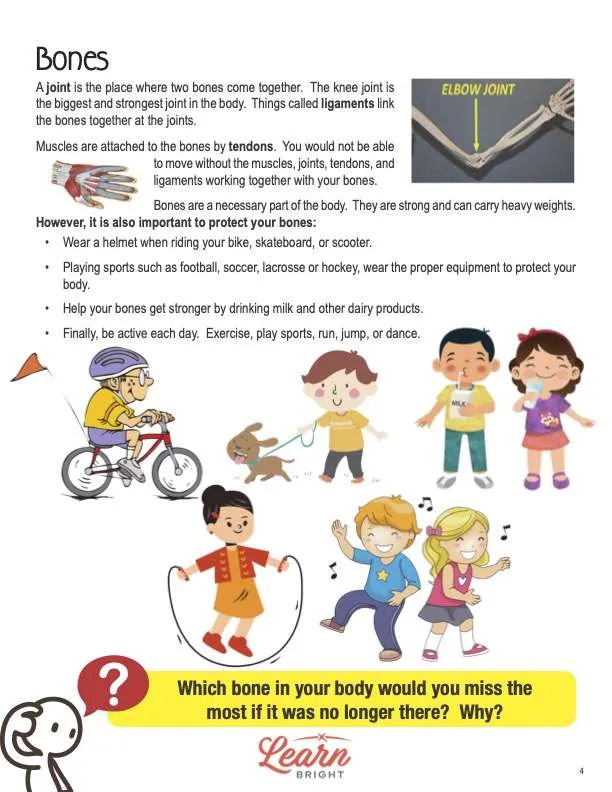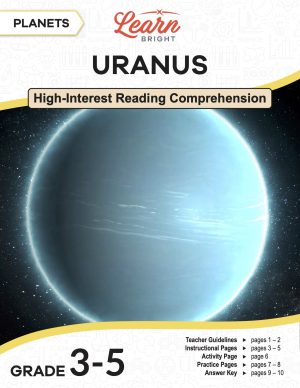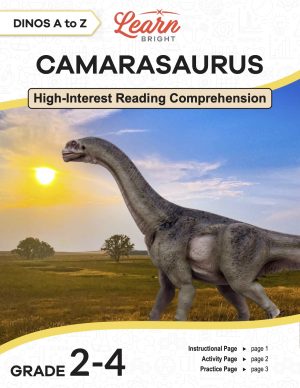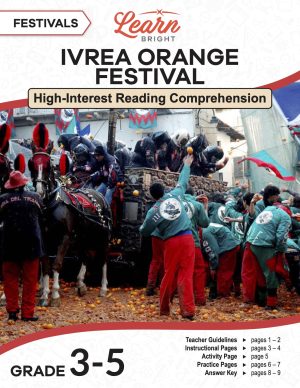Description
What our Bones lesson plan includes
Lesson Objectives and Overview: Bones explores several basic areas of the human skeleton. Students will discover where certain bones are on a skeleton and how to identify them. In addition, they will learn about different ways to help protect their bones from injury. This lesson is for students in 1st grade, 2nd grade, and 3rd grade.
Classroom Procedure
Every lesson plan provides you with a classroom procedure page that outlines a step-by-step guide to follow. You do not have to follow the guide exactly. The guide helps you organize the lesson and details when to hand out worksheets. It also lists information in the yellow box that you might find useful. You will find the lesson objectives, state standards, and number of class sessions the lesson should take to complete in this area. In addition, it describes the supplies you will need as well as what and how you need to prepare beforehand.
Options for Lesson
There are several suggestions in the “Options for Lesson” section that you can add to or incorporate into your lesson. One such suggestion is to allow students to work in pairs for the activity so they can help each other as they complete the worksheet. You could also have students trace their bodies on large paper and then label the bones they learned about. If you can gain access to a model skeleton, students could use to identify each of the bones as you go through the lesson. Another suggestion is to contact a doctor or hospital for X-rays to display to the class. For older students, you could also introduce the scientific names of each bone.
Teacher Notes
This page provides you some extra ideas or guidance on the lesson. The intent of this lesson is to introduce students to the human skeleton at an elementary level. They will only learn about a few major bones. However, you can gauge the class’s level of comprehension and adjust wherever you see fit. There are several blank lines for you to write any more ideas or notes you have before teaching the class this lesson.
BONES LESSON PLAN CONTENT PAGES
Types of Bones
There are two pages of content in this lesson. The first page displays a skeleton and labels several of the specific bones that students should recognize. The lesson starts by asking students why they don’t simply fall down when they stand up. It explains that we can stand, walk, and run because of our bones, which support our bodies. They provide the structure on which the skin hangs and the support and protection for every other part of the body. The skull, for instance, protects the brain and the eyes, face, jaw, nose, and ears.
This lesson continues by explaining several other major bones. The arm bones connect to the collarbone and shoulder bone at the top and then the hand at the bottom. The rib cage covers and protects the organs in the chest and back, such as the heart, lungs, and stomach. The human body typically has 12 pairs of ribs, and they all come in different sizes. The sternum, or breastbone, is part of the rib cage. It is a very hard bone in the center of the chest. It also helps protect the heart and lungs, as well as major blood vessels. The spine that runs down the back protects the spinal cord, which is the path the brain uses to send messages throughout the body.
Students will also learn about some bones in the lower body. The bones in the legs attach to the bottom of the spine by a special group of bones: the pelvis. The upper part of the leg is the thigh bone, which connects to the knee. The lower leg has two bones that attach to the knee and down to the foot.
The Skeleton
The whole bone structure of the body is the skeleton. When a baby is born, it has about 300 bones. However, as people age, some of the bones join together. Generally speaking, adults have a total of 206 bones. About 52 of them make up just the feet and ankles! There are several other parts of the body that work with the skeleton to keep bodies healthy and active.
The bones work with muscles and joints to allow body movement. A joint is the place where two bones come together. The largest and strongest joint in the human body is the knee joint. Ligaments link bones together at the joints. Muscles attach to bones with tendons. Students will discover that they would not be able to move without the muscles, joints, tendons, and ligaments working together with their bones.
These important skeletal structures are necessary to the body. They are strong and can carry heavy weights. However, students will learn that just as their bones protect other parts of their bodies, they should protect their bones. The lesson lists several examples of precautions students should take to help them protect their bodies. They would wear helmets when riding bikes, skateboards, or scooters. If they play sports such as football, soccer, lacrosse, or hockey, they need to wear the proper equipment to protect themselves from injury. They can also strengthen their bones by drinking milk and other dairy products. And finally, they should move. Exercise, sports, running, jumping, dancing, and whatever else they can think of will all help them remain strong.
Key Terms
Here is a list of the vocabulary words students will learn in this lesson plan:
- Bone: a structure of the body on which skin hangs that help provide support and protection for the rest of the body
- Spinal cord: the path by which the brain can send messages throughout the body
- Rib cage (ribs): the bones that protect the organs in the chest region of the body
- Pelvis: a group of bones that attach the leg bones to the bottom of the spine
- Skeleton: the whole bone structure of the body
- Joint: a place where two bones come together
- Ligament: the tissue that links bones together at the joints
- Tendon: a tissue that connects muscles with the bones
BONES LESSON PLAN WORKSHEETS
There are three worksheets in the Bones lesson plan: an activity worksheet, a practice worksheet, and a homework assignment. The goal is to help students grasp the concepts in the lesson in different ways. You can use the classroom procedure guide to know when to hand out each worksheet.
COLOR THE SKELETON ACTIVITY
For the activity, students will cut out each bone from the first worksheet. They will then glue them all onto a separate sheet of paper in the right places. They can color them if they want to or keep them white. The second worksheet page shows 12 bones. Students will have to figure out which area of the skeleton the specific bone represents and color it a unique color.
If you prefer, students can work with a partner for the activity. However, they will need to complete their own skeletons. As an alternative, the activity in the “Options for Lesson” section describes having students trace themselves on large pieces of paper. Then they can draw and label the different bones there. You could also do all three activities if time permits.
LABEL THE SKELETON PRACTICE WORKSHEET
Students must use a word bank to correctly label a skeleton. They may need to refer back to the information from the content pages for some clues. It is also possible that they will need to do some research to complete the worksheet. The lesson does not describe every single part of the skeleton that this worksheet lists.
BONES HOMEWORK ASSIGNMENT
The homework assignment requires students to fill in the blanks on 20 statements. The statements relate to what they learned during the lesson. Students may need to refer back to the content pages to find their answers. The word bank provides the 20 options, and students will use each option only once.
Worksheet Answer Keys
The final pages of the Bones lesson plan document provides answer keys for the worksheets. This includes an answer for the activity since there are specific correct answers. The answer key for the activity shows a skeleton with different colors matching the correct bones. The answer key for the practice worksheet provides the answers in red. As an option, you may choose to display this page for a set amount of time while students study it. Then you can put it away while they try to remember where all the bones were. The answer key for the homework assignment likewise provides the correct answers in red. If you choose to administer the lesson pages to your students via PDF, you will need to save a new file that omits these pages. Otherwise, you can simply print out the applicable pages and keep these as reference for yourself when grading assignments.









